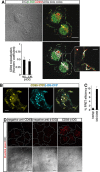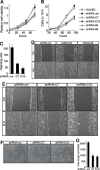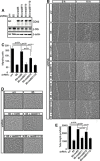CD93 and dystroglycan cooperation in human endothelial cell adhesion and migration adhesion and migration
- PMID: 26848865
- PMCID: PMC4891106
- DOI: 10.18632/oncotarget.7136
CD93 and dystroglycan cooperation in human endothelial cell adhesion and migration adhesion and migration
Abstract
CD93 is a transmembrane glycoprotein predominantly expressed in endothelial cells. Although CD93 displays proangiogenic activity, its molecular function in angiogenesis still needs to be clarified. To get molecular insight into the biological role of CD93 in the endothelium, we performed proteomic analyses to examine changes in the protein profile of endothelial cells after CD93 silencing. Among differentially expressed proteins, we identified dystroglycan, a laminin-binding protein involved in angiogenesis, whose expression is increased in vascular endothelial cells within malignant tumors. Using immunofluorescence, FRET, and proximity ligation analyses, we observed a close interaction between CD93 and β-dystroglycan. Moreover, silencing experiments showed that CD93 and dystroglycan promoted endothelial cell migration and organization into capillary-like structures. CD93 proved to be phosphorylated on tyrosine 628 and 644 following cell adhesion on laminin through dystroglycan. This phosphorylation was shown to be necessary for a proper endothelial migratory phenotype. Moreover, we showed that during cell spreading phosphorylated CD93 recruited the signaling protein Cbl, which in turn was phosphorylated on tyrosine 774. Altogether, our results identify a new signaling pathway which is activated by the cooperation between CD93 and dystroglycan and involved in the control of endothelial cell function.
Keywords: C1qRp; Cbl; Src; angiogenesis; signal transduction.
Conflict of interest statement
The authors declare no conflicts of interest.
Figures






Similar articles
-
C-type lectin domain group 14 proteins in vascular biology, cancer and inflammation.FEBS J. 2019 Sep;286(17):3299-3332. doi: 10.1111/febs.14985. Epub 2019 Jul 29. FEBS J. 2019. PMID: 31287944 Free PMC article. Review.
-
CD93 Signaling via Rho Proteins Drives Cytoskeletal Remodeling in Spreading Endothelial Cells.Int J Mol Sci. 2021 Nov 17;22(22):12417. doi: 10.3390/ijms222212417. Int J Mol Sci. 2021. PMID: 34830297 Free PMC article.
-
Dissecting the CD93-Multimerin 2 interaction involved in cell adhesion and migration of the activated endothelium.Matrix Biol. 2017 Dec;64:112-127. doi: 10.1016/j.matbio.2017.08.003. Epub 2017 Sep 11. Matrix Biol. 2017. PMID: 28912033
-
The small GTPase Rab5c is a key regulator of trafficking of the CD93/Multimerin-2/β1 integrin complex in endothelial cell adhesion and migration.Cell Commun Signal. 2019 May 28;17(1):55. doi: 10.1186/s12964-019-0375-x. Cell Commun Signal. 2019. PMID: 31138217 Free PMC article.
-
CD93 and related family members: their role in innate immunity.Curr Drug Targets. 2008 Feb;9(2):130-8. doi: 10.2174/138945008783502421. Curr Drug Targets. 2008. PMID: 18288964 Review.
Cited by
-
Bioinformatics Approaches to Predict Mutation Effects in the Binding Site of the Proangiogenic Molecule CD93.Front Bioinform. 2022 Jun 21;2:891553. doi: 10.3389/fbinf.2022.891553. eCollection 2022. Front Bioinform. 2022. PMID: 36353214 Free PMC article.
-
Short-Lived Cages Restrict Protein Diffusion in the Plasma Membrane.Sci Rep. 2016 Oct 11;6:34987. doi: 10.1038/srep34987. Sci Rep. 2016. PMID: 27725698 Free PMC article.
-
Designing Cardiovascular Implants Taking in View the Endothelial Basement Membrane.Int J Mol Sci. 2021 Dec 4;22(23):13120. doi: 10.3390/ijms222313120. Int J Mol Sci. 2021. PMID: 34884923 Free PMC article. Review.
-
C-type lectin domain group 14 proteins in vascular biology, cancer and inflammation.FEBS J. 2019 Sep;286(17):3299-3332. doi: 10.1111/febs.14985. Epub 2019 Jul 29. FEBS J. 2019. PMID: 31287944 Free PMC article. Review.
-
Significance of Soluble CD93 in Type 2 Diabetes as a Biomarker for Diabetic Nephropathy: Integrated Results from Human and Rodent Studies.J Clin Med. 2020 May 8;9(5):1394. doi: 10.3390/jcm9051394. J Clin Med. 2020. PMID: 32397261 Free PMC article.
References
-
- Lamalice L, Le Boeuf F, Huot J. Endothelial cell migration during angiogenesis. Circ Res. 2007;100:782–794. - PubMed
-
- Carmeliet P. Angiogenesis in health and disease. Nat Med. 2003;9:653–660. - PubMed
-
- Greenlee MC, Sullivan SA, Bohlson SS. CD93 and related family members: their role in innate immunity. Curr Drug Targets. 2008;9:130–138. - PubMed
Publication types
MeSH terms
Substances
LinkOut - more resources
Full Text Sources
Other Literature Sources
Molecular Biology Databases
Miscellaneous

